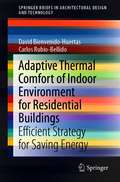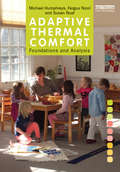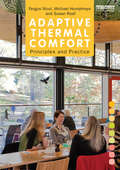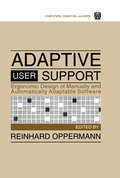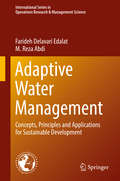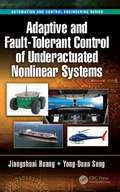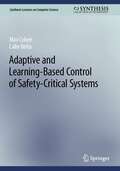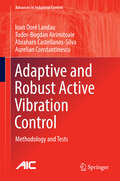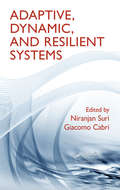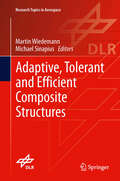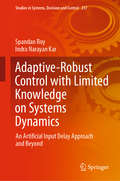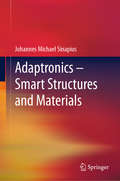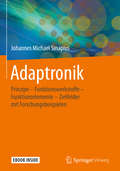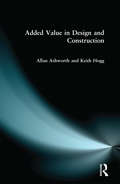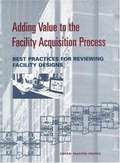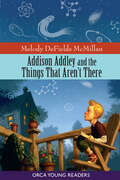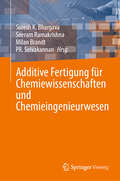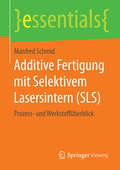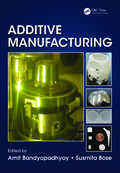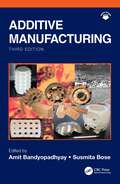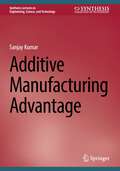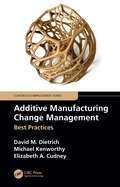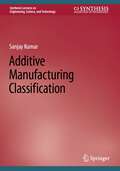- Table View
- List View
Adaptive Thermal Comfort of Indoor Environment for Residential Buildings: Efficient Strategy for Saving Energy (SpringerBriefs in Architectural Design and Technology)
by Carlos Rubio-Bellido David Bienvenido-HuertasThis book is structured in four parts: First, it analyzes the sustainability objectives established for the building stock and the importance of thermal comfort in this aspect. Second, the existing adaptive thermal comfort models and the main energy-saving measures associated with these models are analyzed. Third, the energy savings obtained with these measures are analyzed in several case studies, comparing the results obtained with other energy conservation measures, such as the improvement of the façade. The analysis is carried out from an energy and economic perspective. Finally, a decision‐making process based on fuzzy logic is established. As an expected result, the content of the book contributes to assist architects in designing more efficient buildings from the perspective of user behavior.
Adaptive Thermal Comfort: Foundations And Analysis
by Susan Roaf Michael Humphreys Fergus NicolThere has been widespread dissatisfaction with accepted models for predicting the conditions that people will find thermally comfortable in buildings. These models require knowledge about clothing and activity, but can give little guidance on how to quantify them in any future situation. This has forced designers to make assumptions about people’s future behaviour based on very little information and, as a result, encouraged static design indoor temperatures. This book is the second in a three volume set covering all aspects of Adaptive Thermal Comfort. The first part narrates the development of the adaptive approach to thermal comfort from its early beginnings in the 1960s. It discusses recent work in the field and suggests ways in which it can be developed and modelled. Such models can be used to set dynamic, interactive standards for thermal comfort which will help overcome the problems inherited from the past. The second part of the volume engages with the practical and theoretical problems encountered in field studies and in their statistical analysis, providing guidance towards their resolution, so that valid conclusions may be drawn from such studies.
Adaptive Thermal Comfort: The Designer's Guide To Adaptive Thermal Comfort
by Susan Roaf Michael Humphreys Fergus NicolThe fundamental function of buildings is to provide safe and healthy shelter. For the fortunate they also provide comfort and delight. In the twentieth century comfort became a 'product' produced by machines and run on cheap energy. In a world where fossil fuels are becoming ever scarcer and more expensive, and the climate more extreme, the challenge of designing comfortable buildings today requires a new approach. This timely book is the first in a trilogy from leaders in the field which will provide just that. It explains, in a clear and comprehensible manner, how we stay comfortable by using our bodies, minds, buildings and their systems to adapt to indoor and outdoor conditions which change with the weather and the climate. The book is in two sections. The first introduces the principles on which the theory of adaptive thermal comfort is based. The second explains how to use field studies to measure thermal comfort in practice and to analyze the data gathered. Architects have gradually passed responsibility for building performance to service engineers who are largely trained to see comfort as the ‘product’, designed using simplistic comfort models. The result has contributed to a shift to buildings that use ever more energy. A growing international consensus now calls for low-energy buildings. This means designers must first produce robust, passive structures that provide occupants with many opportunities to make changes to suit their environmental needs. Ventilation using free, natural energy should be preferred and mechanical conditioning only used when the climate demands it. This book outlines the theory of adaptive thermal comfort that is essential to understand and inform such building designs. This book should be required reading for all students, teachers and practitioners of architecture, building engineering and management – for all who have a role in producing, and occupying, twenty-first century adaptive, low-carbon, comfortable buildings.
Adaptive User Support: Ergonomic Design of Manually and Automatically Adaptable Software
by Reinhard OppermannThe potential of software applications to solve an array of office and administrative problems is increasing faster than the ability of users to exploit it. We need to make systems easier to learn and more comfortable to use. This book reports a major advance in the effort to accomplish both goals. Flexcel enables users to modify access and dialog dynamics to their specific requirements. Relying on a plan recognition feature, the system proposes adaptations or uses of adaptations. The ongoing conflict between the adaptive and the adaptable is resolved in an integration: user and system share the responsibility for the initiatives, decision-making and execution. A "critic" component of the system then analyzes the user's handling of the adaptation tools and suggests improvements. The system offers an environment in which users can explore as they learn. HyPlan implements the context-sensitive help that facilitates learning on demand. When the PLANET plan-recognition feature identifies the kinds of support for work that may possibly be required, HyPlan provides, on request, specific assistance in the form of hypermedia or animated displays and tutorials. Developmental research has shown that users take advantage of opportunities to adapt interfaces only in conjunction with help-functions -- which are accepted when they do not interrupt work. And studies by social scientists have shown that adaptations of technical systems have to be integrated into the overall process of organizational innovation and undertaken cooperatively. This book will stimulate all those concerned with software -- from computational, cognitive, ergonomic, or organizational standpoints -- to reconceive the relationship between design and user support.
Adaptive Water Management: Concepts, Principles and Applications for Sustainable Development (International Series in Operations Research & Management Science #258)
by Farideh Delavari Edalat M. Reza AbdiThis book explores a new framework of Adaptive Water Management (AWM) for evaluating existing approaches in urban water management. It highlights the need to adopt multidisciplinary strategies in water management while providing an in-depth understanding of institutional interactions amongst different water related sectors. The key characteristics of AWM i. e. polycentric governance, organisational flexibility and public participation are investigated and described through a critical review of the relevant literature. The book presents an empirical case study undertaken in a selected developing-country city to investigate the potential gaps between the current water management approaches and possible implementation of AWM. Feasibility of AWM operations is examined in an environment surrounded by established water management structure with centralised governance and an institutional process based on technical flexibility. The key elements of AWM performance are (re)structured and transformed into decision support systems. Multi criteria decision models are developed to facilitate quantification and visualization of the elements derived from the case study, which is involved with water companies and water consumers. The book describes how the concept of AWM, along with structuring suitable decision support systems, can be developed and applied to developing-country cities. The book highlights the barriers for applying the AWM strategies that include established centralised decision making, bureaucratic interactions with external organisations, lack of organisational flexibility within the institutions, and lack of recognition of public role in water management. The findings outline that despite the lack of adaptability in the current water management in the case study, as an example of developing countries, there are positive attitudes among water professionals and the public towards adaptability through public-institutional participation. /p>
Adaptive Wireless Communications
by Daniel W. Bliss Siddhartan GovindasamyAdopting a balanced mix of theory, algorithms and practical design issues, this comprehensive volume explores cutting-edge applications in adaptive wireless communications and the implications these techniques have for future wireless network performance. Presenting practical concerns in the context of different strands from information theory, parameter estimation theory, array processing and wireless communication, the authors present a complete picture of the field. Topics covered include advanced multiple-antenna adaptive processing, ad hoc networking, MIMO, MAC protocols, space-time coding, cellular networks and cognitive radio, with the significance and effects of both internal and external interference a recurrent theme throughout. A broad, self-contained technical introduction to all the necessary mathematics, statistics, estimation theory and information theory is included, and topics are accompanied by a range of engaging end-of-chapter problems. With solutions available online, this is the perfect self-study resource for students of advanced wireless systems and wireless industry professionals.
Adaptive and Fault-Tolerant Control of Underactuated Nonlinear Systems (Automation and Control Engineering)
by Yong-Duan Song Jiangshuai HuangThe purpose of the book is to provide an exposition of recently developed adaptive and fault-tolerant control of underactuated nonlinear systems. Underactuated systems are abundant in real life, ranging from landing vehicles to surface ships and underwater vehicles to spacecrafts. For the tracking and stabilization control of underactuated mechanical systems, many methodologies have been proposed. However, a number of important issues deserve further investigation. In response to these issues, four important problems are solved in this book, including control of underactuated nonlinear systems with input saturation, output-feedback control in the presence of parametric uncertainties, fault-tolerant control of underactuated ships with or without actuator redundancy, and adaptive control of multiple underactauted nonlinear systems, including formation control and flocking control of multiple underactuated systems.
Adaptive and Learning-Based Control of Safety-Critical Systems (Synthesis Lectures on Computer Science)
by Calin Belta Max CohenThis book stems from the growing use of learning-based techniques, such as reinforcement learning and adaptive control, in the control of autonomous and safety-critical systems. Safety is critical to many applications, such as autonomous driving, air traffic control, and robotics. As these learning-enabled technologies become more prevalent in the control of autonomous systems, it becomes increasingly important to ensure that such systems are safe. To address these challenges, the authors provide a self-contained treatment of learning-based control techniques with rigorous guarantees of stability and safety. This book contains recent results on provably correct control techniques from specifications that go beyond safety and stability, such as temporal logic formulas. The authors bring together control theory, optimization, machine learning, and formal methods and present worked-out examples and extensive simulation examples to complement the mathematical style of presentation. Prerequisites are minimal, and the underlying ideas are accessible to readers with only a brief background in control-theoretic ideas, such as Lyapunov stability theory.
Adaptive and Robust Active Vibration Control: Methodology and Tests (Advances in Industrial Control)
by Ioan Doré Landau Tudor-Bogdan Airimițoaie Abraham Castellanos-Silva Aurelian ConstantinescuThis book approaches the design of active vibration control systems from the perspective of today s ideas of computer control. It formulates the various design problems encountered in the active management of vibration as control problems and searches for the most appropriate tools to solve them. The experimental validation of the solutions proposed on relevant tests benches is also addressed. To promote the widespread acceptance of these techniques, the presentation eliminates unnecessary theoretical developments (which can be found elsewhere) and focuses on algorithms and their use. The solutions proposed cannot be fully understood and creatively exploited without a clear understanding of the basic concepts and methods, so these are considered in depth. The focus is on enhancing motivations, algorithm presentation and experimental evaluation. MATLAB(r)routines, Simulink(r) diagrams and bench-test data are available for download and encourage easy assimilation of the experimental and exemplary material. Three major problems are addressed in the book: active damping to improve the performance of passive absorbers;adaptive feedback attenuation of single and multiple tonal vibrations; andfeedforward and feedback attenuation of broad band vibrations. Adaptive and Robust Active Vibration Control will interest practising engineers and help them to acquire new concepts and techniques with good practical validation. It can be used as the basis for a course for graduate students in mechanical, mechatronics, industrial electronics, aerospace and naval engineering. Readers working in active noise control will also discover techniques with a high degree of cross-over potential for use in their field. "
Adaptive, Dynamic, and Resilient Systems
by Niranjan Suri Giacomo CabriAs the complexity of today's networked computer systems grows, they become increasingly difficult to understand, predict, and control. Addressing these challenges requires new approaches to building these systems. Adaptive, Dynamic, and Resilient Systems supplies readers with various perspectives of the critical infrastructure that systems of netwo
Adaptive, tolerant and efficient composite structures: Adaptive, Tolerant And Efficient Composite Structures (Research Topics in Aerospace)
by Martin Wiedemann Michael SinapiusComposite structures are most efficient in performance and production cost when combined with smart materials making them adaptable to changing operational conditions. The specific production processes of composites offer the possibility to integrate more functions thus making the structure more valuable. Active functions can be realized by smart materials, e.g. morphing, active vibration control, active structure acoustic control or structure health monitoring. The foundation is a sound understanding of materials, design methods, design principles, production technologies and adaptronics. Along the complete process chain this disciplines together deliver advanced lightweight solutions for applications ranging from mechanical engineering to vehicles, airframe and finally space structures. This book provides the scientific foundations as well as inspiring new ideas for engineers working in the field of composite lightweight structures.
Adaptive-Robust Control with Limited Knowledge on Systems Dynamics: An Artificial Input Delay Approach and Beyond (Studies in Systems, Decision and Control #257)
by Spandan Roy Indra Narayan KarThe book investigates the role of artificial input delay in approximating unknown system dynamics, referred to as time-delayed control (TDC), and provides novel solutions to current design issues in TDC. Its central focus is on designing adaptive-switching gain-based robust control (ARC) for a class of Euler–Lagrange (EL) systems with minimal or no knowledge of the system dynamics parameters. The newly proposed TDC-based ARC tackles the commonly observed over- and under-estimation issues in switching gain. The consideration of EL systems lends a practical perspective on the proposed methods, and each chapter is supplemented by relevant experimental data. The book offers a unique resource for researchers in the areas of ARC and TDC alike, and covers the state of the art, new algorithms, and future directions.
Adaptronics – Smart Structures and Materials
by Johannes Michael SinapiusSince the 1980s, scientists have been researching adaptive structures for materials, for multifunctional elements or even for complete systems. Adaptronics (smart materials, smart structures, smart systems) is a field of distinct interdisciplinarity. The book therefore offers an interdisciplinary view of adaptronic systems, materials and functional elements and their applications. The subject matter integrates various engineering disciplines, from electrical engineering and information technology to manufacturing and control engineering, materials engineering and structural mechanics - to name but a few of the relevant subject areas. Starting from the basic principles and variants of adaptronic systems and functional materials, the textbook explains the different construction methods of functional elements. Building on this, readers learn how to apply this knowledge to active shape control, active vibration control and active vibroacoustics. For each of these topics the author presents current examples from research, discusses research results and future research questions. Each of the nine chapters closes with references to further literature. An index of the mathematical symbols used and a keyword index facilitate learning for readers.The book is aimed at Master's students in engineering courses such as mechanical engineering, aerospace engineering, mechatronics, automotive engineering and related courses. The book provides a comprehensive overview for industrial practitioners who want to familiarize themselves with the field of adaptronics and also serves as a reliable reference book.
Adaptronik: Prinzipe - Funktionswerkstoffe - Funktionselemente - Zielfelder mit Forschungsbeispielen
by Johannes Michael SinapiusSeit den achtziger Jahren forschen Wissenschaftler an adaptiven Strukturen für Materialien, für multifunktionale Elemente oder sogar für vollständige Systeme. Dabei ist die Adaptronik (englisch: smart materials, smart structures, smart systems) ein Fachgebiet von ausgeprägter Interdisziplinarität. Das Buch bietet daher eine interdisziplinäre Betrachtung von adaptronischen Systemen, Werkstoffen und Funktionselementen und ihren Anwendungen. Der Lehrstoff integriert verschiedene ingenieurwissenschaftliche Disziplinen, von Elektro- und Informationstechnik über Fertigungs- und Regelungstechnik bis zu Werkstofftechnik und Strukturmechanik – um nur einige der relevanten Fachgebiete zu nennen. Ausgehend von den grundlegenden Prinzipien und Varianten adaptronischer Systeme und Funktionswerkstoffe werden in dem Lehrbuch die unterschiedlichen Bauweisen von Funktionselementen erläutert. Darauf aufbauend lernen Leser, wie diese Kenntnisse auf die aktive Formkontrolle, die aktive Vibrationskontrolle und die aktive Vibroakustik anzuwenden sind. Für jedes dieser Themenfelder stellt der Autor aktuelle Beispiele aus der Forschung vor, diskutiert Forschungsergebnisse und zukünftige Forschungsfragen. Jedes der neun Kapitel schließt mit Hinweisen auf weiterführende Literatur. Ein Verzeichnis der verwendeten mathematischen Symbole und ein Stichwortverzeichnis erleichtern Lesern das Lernen.Das Buch wendet sich an Masterstudierende in ingenieurwissenschaftlichen Studiengängen wie Maschinenbau, Luft- und Raumfahrttechnik, Mechatronik, Kraftfahrzeugtechnik sowie verwandte Studiengänge. Praktikern in der Industrie, die sich in das Gebiet der Adaptronik einarbeiten wollen, bietet das Buch einen umfassenden Überblick und es dient zugleich ein zuverlässiges Nachschlagewerk.
Added Value in Design and Construction
by Allan Ashworth Keith HoggAdded Value in Design and Construction takes a holistic, student-centred approach to offering public and private sector clients the ultimate reward; doing more for less. The Latham Report was a call to action and this book provides students of construction with the theoretical and practical knowledge to deliver the recommendations of the report. It describes the principles and techniques crucial to adding value and reducing costs in design and construction in the twenty first century. This book examines in detail a wide range of strategies that can be applied during the design and construction process to add value and bring the best interests of the client sharply into focus.
Addie and Bea Make Adobe
by Amy TaoAddie and Bea use the perfect material to build a house in the desert—adobe!
Adding Value to the Facility Acquisition Process: BEST PRACTICES FOR REVIEWING FACILITY DESIGNS
by Ralph S. SpillingerReport on Adding Value to the Facility Acquisition Process.
Addison Addley and the Things That Aren't There (Orca Young Readers)
by Melody DeFields McMillanAddison Addley hates math. He hates public speaking too. Actually, he hates anything that involves work, but he only has a couple of weeks to write and memorize his grade five speech. The problem is, he can't think of a single topic. When he finally comes up with an excellent idea for a speech, it almost writes itself, but it's his poor math skills that make speech day unforgettable.
Additive Fertigung für Chemiewissenschaften und Chemieingenieurwesen
by Seeram Ramakrishna Suresh K. Bhargava Milan Brandt Pr. SelvakannanDieses Buch ist speziell für Forscher sowie Lehrende konzipiert, die einen Fortgeschrittenen-Fertigungs-Kurs in ihren Klassen unterrichten oder einführen. Es präsentiert den aktuellen Forschungsstand in diesem Forschungsbereich und die bisher identifizierten Hauptprobleme für die Integration der additiven Fertigung in chemische Prozesse. Die einzigartige Fähigkeit, Materialien mithilfe aufkommender additiver Fertigungstechnologien in funktionale Bauteile mit spezifischer Geometrie zu verwandeln, hat in Biologie, Ingenieurwissenschaften und Materialwissenschaften erhebliches Interesse geweckt, um maßgeschneiderte Designs für spezifische Anwendungen zu erstellen. Die Anwendungen dieses aufstrebenden Fertigungsverfahren im Bereich der chemischen Wissenschaften und des Ingenieurwesens sind im Anfangssdtadium. Daher liegt der Hauptfokus dieses Buches darauf, die grundlegenden Prinzipien der additiven Fertigungsverfahren sowie den Einsatz in konventionelle chemische Prozesse und verschiedeneVerfahrenstechniken einzuführen. Der potenzielle Vorteil der Anwendung dieser additiven Fertigungstechnologien besteht darin, großtechnisch chemische Prozesse herunterzuskalieren, was mehrere Vorteile bietet, darunter eine geringere Flächenbedarf, Abfallreduktion, effiziente Wärmeintegration und dezentrale chemische Fertigung. Was ist Additive Fertigung? Additive Fertigung (engl.: additive manufacturing, AM) – weitgehend auch als 3D-Druck bezeichnet – ist ein aufstrebendes und innovatives Fertigungsverfahren, das sich grundlegend von konventionellen Herstellungsprozessen unterscheidet und der Forschung und Industrie zu völlig neuen Möglichkeiten verhilft. Bauteile werden Schicht für Schicht aufgebaut und entstehen nicht wie bei herkömmlichen Verfahren durch Abtrag von Material (zum Beispiel durch fräsende Bearbeitung). Dadurch ergibt sich eine enorme Flexibilität und Designfreiheit beispielsweise bei der Herstellung von Prototypen und auch zunehmend in der Serienfertigung. Die Zukunft der additiven Fertigung Die additive Fertigung zählt zu den starken Wachstumsfeldern innerhalb der Produktion. Führende Marktberichte sagen ein durchschnittliches jährliches Wachstum von ca. 20 Prozent für die nächsten fünf Jahre voraus. Das Fraunhofer IGCV geht dabei davon aus, dass dieses Branchenwachstum der additiven Fertigung nicht nur in einem spezifischen Industriezweig zu beobachten sein wird. Vielmehr ist davon auszugehen, dass in allen Industriezweigen der Einsatz additiver Fertigungsverfahren zunehmen wird. Im Jahr 2022 wurden zur Zukunft der additiven Fertigung zwei Studien (An Additive Manufacturing Breakthrough & The Futures of Metal Additive Manufacturing 2030) veröffentlicht, bei denen das Fraunhofer IGCV Zuarbeiten geleistet hat. Die additive Fertigung zählt zu den starken Wachstumsfeldern innerhalb der Produktion. Führende Marktberichte sagen ein durchschnittliches jährliches Wachstum von ca. 20 Prozent für die nächsten fünf Jahre voraus. Das Fraunhofer IGCV geht dabei davon aus, dass dieses Branchenwachstum der additiven Fertigung nicht nur in einem spezifischen Industriezweig zu beobachten sein wird. Vielmehr ist davon auszugehen, dass in allen Industriezweigen der Einsatz additiver Fertigungsverfahren zunehmen wird. Im Jahr 2022 wurden zur Zukunft der additiven Fertigung zwei Studien (An Additive Manufacturing Breakthrough & The Futures of Metal Additive Manufacturing 2030) veröffentlicht, bei denen das Fraunhofer IGCV Zuarbeiten geleistet hat.
Additive Fertigung mit Selektivem Lasersintern: Prozess- und Werkstoffüberblick (essentials)
by Manfred SchmidDieses essential stellt das Selektive Lasersintern als Verfahren der additiven Fertigung im Kontext anderer 3D-Druck-Prozesse vor. Manfred Schmid erläutert verschiedene Technologien, die zu den additiven Verfahren gezählt werden, und gibt einen Einblick in die Prozessprinzipien und Werkstoffe. Die grundlegenden Werkstoffvarianten unterschiedlicher Hersteller werden ebenso thematisiert wie die Limitationen des Verfahrens aufgrund reduzierter Bauteildichte und -anisotropie. Das anspruchsvolle Verfahren des Lasersinterns, das die Stufe vom Prototyping zur Produktion überwinden und eine ,,echte" Fertigungstechnologie werden kann, wird detailliert, aber dennoch in kompakter Form beschrieben. Ein Ausblick hinsichtlich bereits vorliegender und gewünschter alternativer Materialien rundet das essential ab.
Additive Manufacturing
by Susmita Bose Amit BandyopadhyayThe field of additive manufacturing has seen explosive growth in recent years due largely in part to renewed interest from the manufacturing sector. Conceptually, additive manufacturing, or industrial 3D printing, is a way to build parts without using any part-specific tooling or dies from the computer-aided design (CAD) file of the part. Today, mo
Additive Manufacturing
by Susmita Bose Amit BandyopadhyayThe field of additive manufacturing is growing dynamically, with continued interest from manufacturing and other sectors. Conceptually, additive manufacturing is a method to build parts without using any part-specific tooling or dies from a computer-aided design file. This new edition of Additive Manufacturing highlights the applications in aerospace industries, biomedical devices, and construction industries, with new material on additive manufacturing at the nano- and microscale, as well as questions and additional reading materials.Key features: Covers basics and current technology of 3D printing of all types of materials including detailed discussions of the concerned applications Highlights the latest advancements in 3D printing and additive manufacturing technologies Includes new material on recent applications of additive manufacturing in aerospace, space, biomedical, and construction industries Contains suggested reading, questions for instructors, and PowerPoint slides for each chapter Includes regulatory issues in additive manufacturing This book is intended for students and researchers in the field of mechanical, manufacturing, materials, and industrial engineering.
Additive Manufacturing Advantage (Synthesis Lectures on Engineering, Science, and Technology)
by Sanjay KumarThis book provides a concise introduction to additive manufacturing, accessible to anyone with a basic background in engineering and materials science. The author explains additive manufacturing (AM) in terms of advantages and disadvantages and gives a concise list of advantages and disadvantages, enabling readers to understand AM in relation to other techniques. Additionally, this book clarifies various contradictions with the help of numerous examples.This book:Offers readers a unique, accelerated learning tool, revealing the subtleties of Additive ManufacturingDescribes a concept for refabrication in the context of additive manufacturing, providing new insight into repair and refurbishmentDiscusses additive manufacturing not only as a design tool, but also a production tool in the context of mass-production
Additive Manufacturing Change Management: Best Practices (Continuous Improvement Series)
by David M. Dietrich Michael Kenworthy Elizabeth A. CudneyAdditive Manufacturing (AM) has altered manufacturing as we know it, with shortened development time, increased performance, and reduced product costs. Executive management in industry are bombarded by marketing from their competitors showcasing design solutions leveraged through AM. Therefore, executive management ask their project management teams to figure out how to utilize AM within their own company. Clueless on how to approach the problem, managers start learning about AM from experts and become overwhelmed at the highly technical information. Unlike other AM books that focus on the technical output of AM technology, this new book focuses solely on the managerial implementation. Features Presents the impacts of AM technology Provides engaging, practical, and entertaining "war stories" from the front line of AM industrialization Describes in detail, the significant hurdles in AM certification and implementation Offers templates of proven change management best practices, as practical solutions Omits the technical verbiage that gets in the way of management understanding how the process is implemented
Additive Manufacturing Classification (Synthesis Lectures on Engineering, Science, and Technology)
by Sanjay KumarAdditive manufacturing classification is one of the biggest issues faced by AM community. The book provides a comprehensive classification of AM, which can be useful to anyone working in any area of manufacturing. As the classification depends on the interrelation of various AM processes, the book provides concise and critical information of those processes, which can be helpful to anyone looking for a concise book on AM. The book provides original information unavailable in research papers.
